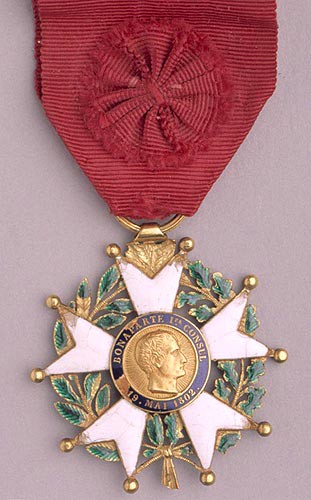After the abolition by the Revolution of the ancient orders of chivalry in the name of égalité, the Légion d'honneur (Legion of Honour), instituted on 29 Floréal, An X (19 May, 1802), was created as an honour of a completely different type. By honouring personal merit, both civil and military, without distinction of birth, the award was “a start towards the organisation of the Nation”, as the First Consul put it. The law which created it did not provide for insignia or motto; a simple letter of notification, signed by the Grand Chancelier, was sent to new members. It was only two years later, by the decree of 22 Messidor, An XII (11 July, 1804), the famous decoration saw the light of day:
“The decoration of the Légion d'Honneur will consist of a five-pointed star, with each point doubled.
The centre of the star, surrounded by a oak and laurel wreath, shall present, on one side, the head of the Emperor, with this legend: 'Napoléon, Emp. des Français' (Napoleon Emperor of the French) and, on the other, the French eagle holding a thunder bolt, with this legend: 'Honneur et Patrie' (Honour and Fatherland).
The decoration will be in white enamel.
It will be in gold for 'Grands-Officiers', 'Commandants' and 'Officiers', and in silver for Legionaires; it shall be worn from one of the buttonholes on the jacket and attached to a red moiré ribbon.”
Four days later, the Emperor, himself wearing for the first time the famous star, the design for which is attributed to the painter David, proceeded to award the first medals in the Church of les Invalides, and later, on 16 August, 1804, at the Camp de Boulogne, at “the distribution to the 'braves' of the army” during a grandiose ceremony in front of about one hundred thousand men.
The Légion d'Honneur has changed remarkably little since its creation; indeed, the form, motto and ribbon are identical to the original. The only variation to have occurred was in terms of the points of the star. Whilst these were initially pointed, the ends were subsequently rounded off because the points snagged on uniforms. However, the 'bélière' (the boss linking the medal to the ribbon which appeared on later models, sometimes in the form of a crown) and the centre of the star were modified according to the different political regimes in France. Sometimes a 'bélière' was added. On the obverse, there were in succession profiles and reliefs of: Napoleon Emperor of the French; Henri IV King of France and Navarre; Bonaparte First Consul; Napoleon Emperor (again); and then the goddess Ceres as the personification of the Republic. On the reverse, there followed in succession: an eagle; a fleurs de lys; tricouleur flags; an eagle; and again tricouleur flags. The model shown here dates from the Second Republic. It is the only one to show on the obverse the image not of Napoleon Emperor but that of Bonaparte First Consul with the date of the creation of the Légion d'Honneur, 19 May, 1802. The ribbon bears a 'bouffette' (the rosette), a feature reserved for officers, the origin of the famous 'rosette'.
Karine Huguenaud (tr. P.H.)
May 2002
Star of the Légion d’honneur


